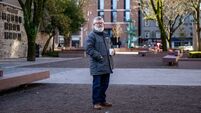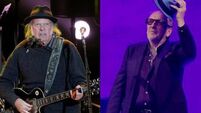Skip the motorway and take the road less travelled

Robert Frost wrote those lines in 1916, so I doubt he was talking about exiting the motorway at Kill to avoid heavy traffic around Naas. But I was thinking about him when I left the certainty, and safety in numbers, of the M8 and took a ‘back road’. It takes a lot to leave a motorway prematurely. For me, the Ms 1, 2, 3, 4, 6, 7, and 8 (the friendliest one, think about it) and 11 are like hard-won civil rights that we campaigned for back in the days of bottlenecks and tailbacks through Abbeyleix, Enfield, Gorey and other towns. To not use them seems a betrayal of the men who drove the diggers.
But motorways are like ready-meals — quick, but expensive and dissatisfying. There are no surprises. The signs are legible, logical. Nature is kept well-back. If you look up, you’ll sometimes see a cow standing high on the edge of a cutting, looking wistfully over at the other side. You just know the cow is thinking: “I’m sure there used to be a field here.” Every so often, it’s good to travel a back road — even when you don’t have to. And by ‘back road’ I don’t mean the next level down from motorways; I mean proper, beep-the-horn-at-the-corners, pull-in-for-the-lad-with-the-baler, unexpected-hump-that-gives-you-the-weird-feeling-in-your-bottom back road. The one you use if you’re going for a spin, or avoiding questions about the validity of the discs on your windscreen.
The first thing to notice is the signs. Their colour has changed. You won’t see any blue ones any more, unless it’s on a giant bit of plywood nailed to a tree, cheering on the local club in the county final.
The directions get more chaotic. Whereas a motorway sign merely has to show an exit or the possibility of the odd prancing deer, a back-road sign has to communicate the vast range of complicated junctions. If a motorway sign says ‘exit coming up’, a back-road sign has to say: ‘it’s a sort of a sharp bend and then there’s a small road on the left, but sort of over a bit there’s another road, don’t take that one, because there’s a second right at the pub and mind over your shoulder, because there could be a fella tearing out from the other side like a lunatic.’ Back roads also have their own, natural traffic-calming measures, such as the point between two gateways, where cows’ hooves, and whatever acids their stomachs have produced, have etched out a little rumble strip.
Speaking of cows, if you’re stuck behind a herd, just accept it. There is no point at beeping at them for going so slowly. Their ambling along the road is a rhythm as old as agriculture itself. Instead of getting angry, just take a deep breath and let their walk — punctuated now and again by the odd bovine bowel movement — lull you towards mindfulness.
Another ambler is the pheasant. A pheasant walking in the verge of an Irish ditch always looks vaguely lost, like a dim-witted English gentleman abandoned by his treacherous Irish gillie. And then there’s the saluting. Next time you are a stranger on an Irish back-road, give over-exuberant waves to every other road user, just to see what kind of puzzled replies you get. You’ll be certain to feature in conversations later that day.
I arrived at Kilkenny last weekend, turned on the car radio and there were still long delays on the motorway at Naas. Turns out Robert Frost was right. It had made all the difference.















